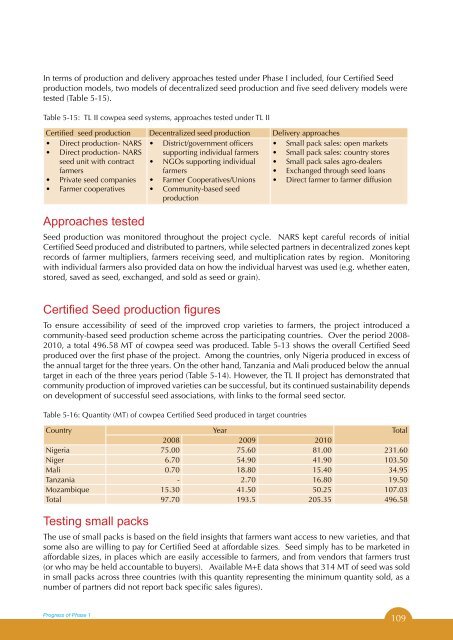Four Seasons of Learning and Engaging Smallholder Farmers - icrisat
Four Seasons of Learning and Engaging Smallholder Farmers - icrisat
Four Seasons of Learning and Engaging Smallholder Farmers - icrisat
You also want an ePaper? Increase the reach of your titles
YUMPU automatically turns print PDFs into web optimized ePapers that Google loves.
In terms <strong>of</strong> production <strong>and</strong> delivery approaches tested under Phase I included, four Certified Seed<br />
production models, two models <strong>of</strong> decentralized seed production <strong>and</strong> five seed delivery models were<br />
tested (Table 5-15).<br />
Table 5-15: TL II cowpea seed systems, approaches tested under TL II<br />
Certified seed production Decentralized seed production Delivery approaches<br />
• Direct production- NARS • District/government <strong>of</strong>ficers • Small pack sales: open markets<br />
• Direct production- NARS supporting individual farmers • Small pack sales: country stores<br />
seed unit with contract • NGOs supporting individual • Small pack sales agro-dealers<br />
farmers<br />
farmers<br />
• Exchanged through seed loans<br />
• Private seed companies • Farmer Cooperatives/Unions • Direct farmer to farmer diffusion<br />
• Farmer cooperatives • Community-based seed<br />
production<br />
Approaches tested<br />
Seed production was monitored throughout the project cycle. NARS kept careful records <strong>of</strong> initial<br />
Certified Seed produced <strong>and</strong> distributed to partners, while selected partners in decentralized zones kept<br />
records <strong>of</strong> farmer multipliers, farmers receiving seed, <strong>and</strong> multiplication rates by region. Monitoring<br />
with individual farmers also provided data on how the individual harvest was used (e.g. whether eaten,<br />
stored, saved as seed, exchanged, <strong>and</strong> sold as seed or grain).<br />
Certified Seed production figures<br />
To ensure accessibility <strong>of</strong> seed <strong>of</strong> the improved crop varieties to farmers, the project introduced a<br />
community-based seed production scheme across the participating countries. Over the period 2008-<br />
2010, a total 496.58 MT <strong>of</strong> cowpea seed was produced. Table 5-13 shows the overall Certified Seed<br />
produced over the first phase <strong>of</strong> the project. Among the countries, only Nigeria produced in excess <strong>of</strong><br />
the annual target for the three years. On the other h<strong>and</strong>, Tanzania <strong>and</strong> Mali produced below the annual<br />
target in each <strong>of</strong> the three years period (Table 5-14). However, the TL II project has demonstrated that<br />
community production <strong>of</strong> improved varieties can be successful, but its continued sustainability depends<br />
on development <strong>of</strong> successful seed associations, with links to the formal seed sector.<br />
Table 5-16: Quantity (MT) <strong>of</strong> cowpea Certified Seed produced in target countries<br />
Country Year Total<br />
2008 2009 2010<br />
Nigeria 75.00 75.60 81.00 231.60<br />
Niger 6.70 54.90 41.90 103.50<br />
Mali 0.70 18.80 15.40 34.95<br />
Tanzania - 2.70 16.80 19.50<br />
Mozambique 15.30 41.50 50.25 107.03<br />
Total 97.70 193.5 205.35 496.58<br />
Testing small packs<br />
The use <strong>of</strong> small packs is based on the field insights that farmers want access to new varieties, <strong>and</strong> that<br />
some also are willing to pay for Certified Seed at affordable sizes. Seed simply has to be marketed in<br />
affordable sizes, in places which are easily accessible to farmers, <strong>and</strong> from vendors that farmers trust<br />
(or who may be held accountable to buyers). Available M+E data shows that 314 MT <strong>of</strong> seed was sold<br />
in small packs across three countries (with this quantity representing the minimum quantity sold, as a<br />
number <strong>of</strong> partners did not report back specific sales figures).<br />
Progress <strong>of</strong> Phase 1<br />
109

















